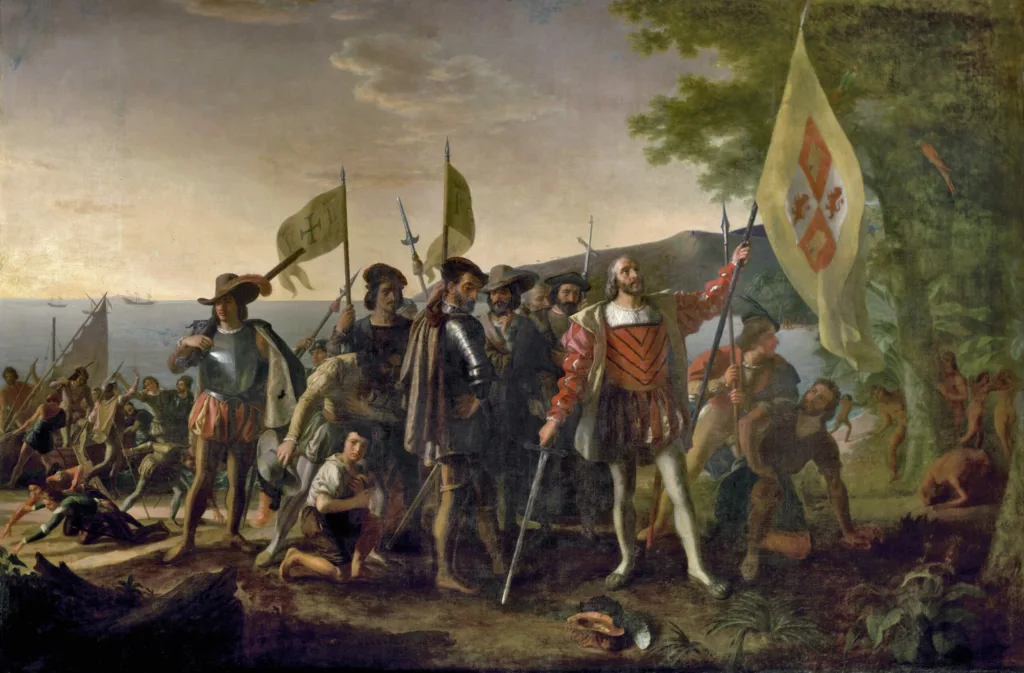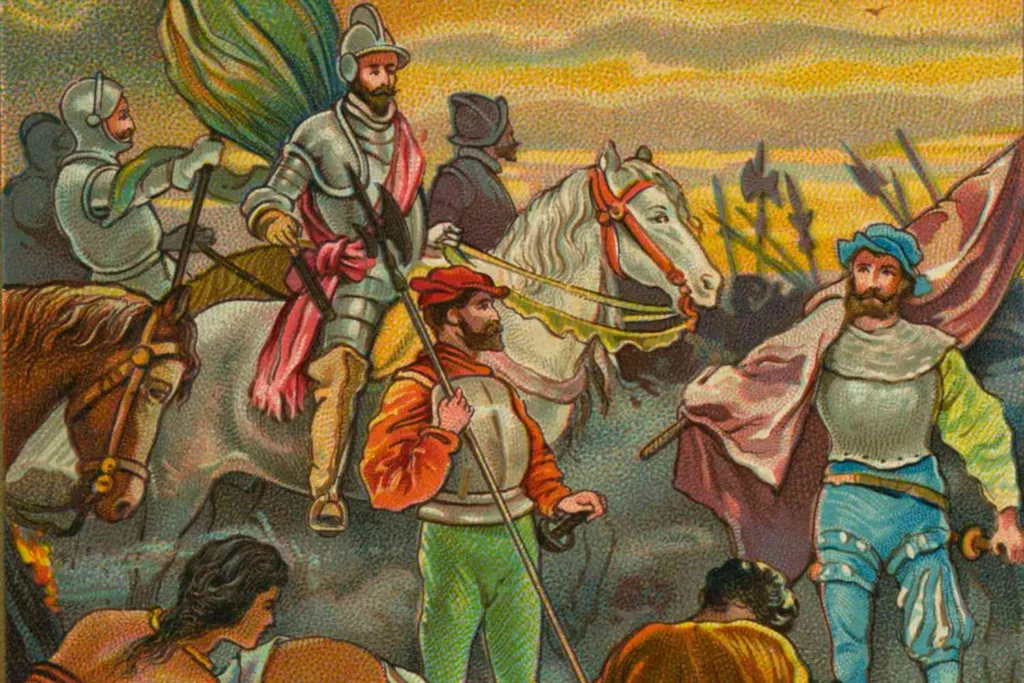The Spanish conquest of the Americas was a brutal and violent period in history. The Spanish conquistadors, who arrived in Hispaniola and later expanded to oher Caribbean islands and the mainland, treated the native peoples with extreme cruelty and disregard for their humanity.
The Spanish, driven by the desire for wealth and power, took what they wanted from the natives, often resorting to violence when met with resistance. They enslaved many of the native peoples, forcing them to work under harsh conditions and subjecting them to physical and emotional abuse.
The Spanish also engaged in widespread slaughter of the native peoples, often killing men, women, and children indiscriminately. They destroyed entire communities, leaving survivors traumatized and forced to flee for their lives.
The Spanish treated the natives as subhuman, using them for their own purposes without any regard for their well-being. They believed that the natives were savages who needed to be civilized and converted to Christianity, and they used this justification to justify their brutal treatment of them.
Despite this, the Spanish did attempt to establish some guidelines for the treatment of the native peoples. The Laws of Burgos, passed in 1512, required that the natives be placed in villages where they would receive religious instruction and be encouraged to marry. The laws also limited the amount of time the natives could be forced to work for the Spaniards and prohibited mistreatment.
However, these laws were often ignored or not enforced, and the Spanish continued to treat the natives with extreme violence and cruelty. The native peoples were forced to endure centuries of oppression and exploitation at the hands of the Spanish, and their culture and way of life were nearly destroyed.
The Spanish conquest of the Americas was a dark period in history marked by extreme violence and cruelty toward the native peoples. The legacy of this period continues to be felt today, as the people of the Americas struggle to reclaim their cultural heritage and overcome the legacy of oppression and exploitation left by the Spanish.
The Treatment of Native Americans by the Spanish
The Spanish conquest of the Americas in the 16th century was marked by violence and brutality towards the Native Americans. The Spanish conquistadors were driven by the desire to acquire wealth and power, and they saw the indigenous people as obstacles to their goals.
The Spanish treated the Native Americans with extreme cruelty, using violence and force to subjugate them. They took what they wanted, including land, gold, and other resources, and often forced the indigenous people to work as slaves.
The Spanish also used religion as a tool of conquest, forcing the Native Americans to convert to Christianity and destroying their own spiritual beliefs and practices. This was done through violence, such as burning sacred objects and temples, and through the use of missionaries.
The Spanish also spread disease among the Native American populations, which had devastating effects. The Native Americans had no immunity to European diseases, and as a result, many died from illnesses such as smallpox, measles, and influenza.
The Spanish treated the Native Americans with great brutality and cruelty, exploiting them for their own gain and showing lttle regard for their well-being or rights.

Treatment of Natives by the Spanish
During the colonization of the Americas, the Spanish treated the natives with extreme violence and brutality. The Spanish considered the natives as inferior and treated them as subhuman creatures. They took natives as slaves and forced them to work in mines and farms. The indigenous people were subjected to harsh treatment, including physical abuse, torture, and murder.
The Spanish were motivated by their desire to exploit the abundant resources of the Americas, and they saw the natives as a means to achieve this goal. The Spanish destroyed the native cultures and civilizations, imposing their own language, religion, and customs on the indigenous people.
The natives came to characterize the Spanish as cruel, ruthless, and greedy. The Spanish were seen as oppressors who had no regard for the lives and well-being of the indigenous people. The natives were forced to live in poverty and misery, and their land was taken away from them withut any compensation.
The Spanish treated the natives with extreme violence and brutality during the colonization of the Americas. The natives were subjected to harsh treatment, including physical abuse, torture, and murder. The Spanish were motivated by their desire to exploit the abundant resources of the Americas, and they saw the natives as a means to achieve this goal. The natives came to characterize the Spanish as cruel, ruthless, and greedy.
Life of Native Americans Under Spanish Rule
Life for Native Americans under Spanish rule varied depending on the region and specific policies implemented. However, in general, Native Americans were forced to give up their traditional lifestyles and adopt Spanish culture and religion.
One of the main policies implemented by the Spanish was the establishment of Indian villages or missions. Native Americans were forced to live in thee villages, where they were closely supervised, baptized, and given religious instruction. This policy aimed to convert Native Americans to Christianity and to assimilate them into Spanish culture.
In these villages, Native Americans were encouraged to marry, and their work for the Spanish was limited to nine months per year. They were supposed to be free and not mistreated, but in reality, they were often subjected to forced labor and abuse.
Native Americans were also forced to work in Spanish mines and plantations, where they were subjected to harsh working conditions and often died from disease and overwork. They were also subjected to forced labor on public works projects, such as building roads and fortifications.
Despite these policies, some Native American communities were able to resist Spanish domination and maintain their traditional lifestyles. However, these communities were often subject to violent suppression by Spanish authorities.
Life for Native Americans under Spanish rule was marked by forced assimilation, enslavement, and abuse. While some Native American communities were able to resist Spanish domination, many were forced to give up their traditional ways of life and adopt Spanish culture and religion.
Forced Assimilation of Natives by Spanish
During the Spanish colonial period, the Spanish authorities had various objectives for the indigenous populations of the Americas. One of the primary objectives was to convert the native people to Christianity. The Spanish colonizers believed that it was their religious duty to convert the native people to Christianity, as they viewed the indigenous populations as heathens who needed to be saved.
Another objective of the Spanish was to pacify the areas for colonial purposes. This involved suppressing any resistance or rebellion from the native populations, whih often led to violent conflicts between the Spanish and the indigenous peoples.
The Spanish also aimed to acculturate the natives to Spanish cultural norms. This involved teaching them Spanish language and customs, as well as introducing them to European-style clothing and food. The ultimate goal was to assimilate the native populations into Spanish society, transforming them into loyal subjects of the Spanish crown.
To achieve these objectives, the Spanish used various methods, including the establishment of missions and the encomienda system. The missions were religious and economic institutions that aimed to educate and Christianize the native populations. The encomienda system, on the other hand, was a labor system that forced the native people to work for Spanish colonizers in exchange for protection and religious instruction.
The Spanish forced the native populations to convert to Christianity, pacify the areas for colonial purposes, and acculturate to Spanish cultural norms. These objectives were achieved through the establishment of missions and the encomienda system, which aimed to transform the native populations into loyal subjects of the Spanish crown.

Conclusion
The Spanish conquest of the Americas was a brutal and violent chapter in world history. The conquistadors had little regard for the native peoples they encountered, and thir actions resulted in the deaths of millions. However, the Spanish also brought with them their culture, language, and religion, which have had a lasting impact on the Americas. Today, Spanish is spoken by millions of people in North, Central, and South America, and the influence of Spanish culture can be seen in everything from food to music to art. While the legacy of the Spanish conquest is a complicated one, it is clear that the impact of the Spanish on the Americas is still being felt today.
